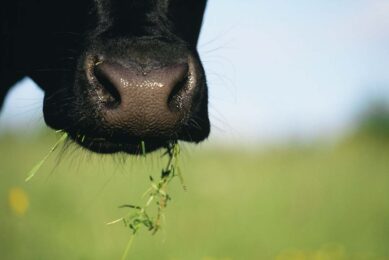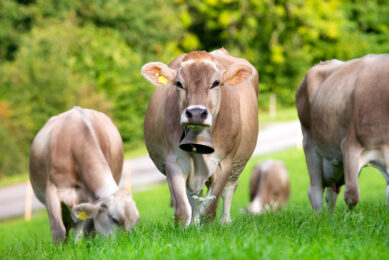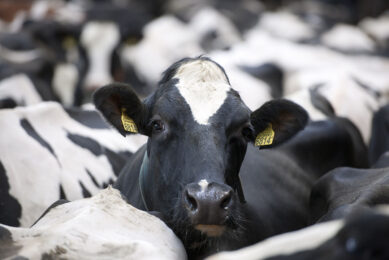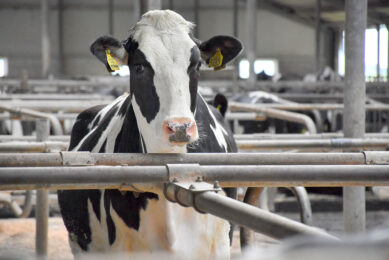Bringing artificial intelligence to the dairy barn
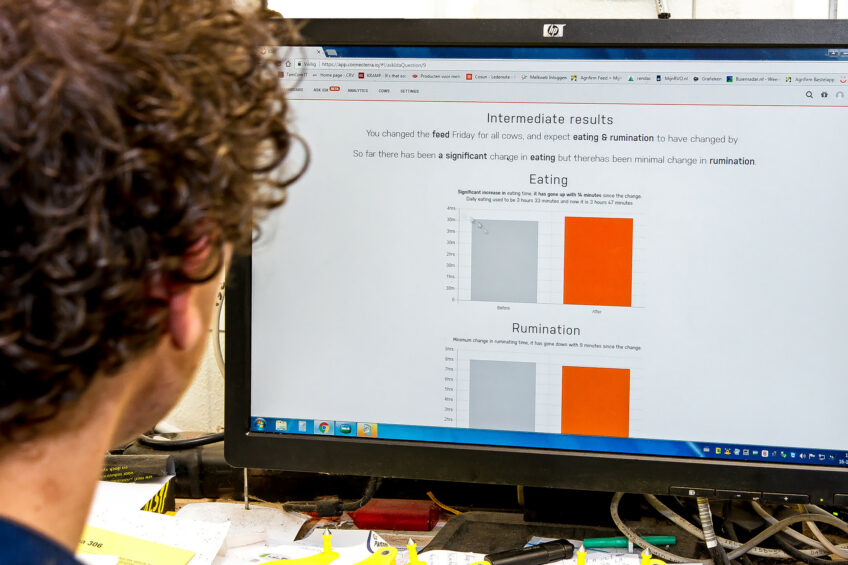
Don’t talk about big data and algorithms to farmers. Talk about the goals of the farm and areas where they want to improve. The data solutions and sensors will follow. This is according to Yasir Khokhar, CEO of Connecterra.
Big data and agriculture. A promising combination and everyone is talking about it. As a result, many drones for farmers, sensors for dairy cows, software packages with fancy dashboards are entering the market. But data is useless unless you can unlock its underlying meaning and help the farmer to take action. Many sensors for cattle for example are based on tracking, which merely relay data to a central collection point.
For example, a farmer gets data on how often the cow walks. This is important for heat detection for example, but the farmer still needs to interpret the data and make a decision on what he or she sees, based on the data gathered by the tracker. Connecterra, a Dutch based company founded by entrepreneur and tech expert Yasir Khokhar, is designed to make life easier for the farmer by taking farm technology to the next level: a system based on continuous learning and intelligence. “Our product combines sensor technology, machine learning and cloud computing to convert raw data into meaningful information to act as a dairy decision-support tool,” Khokhar says.
Khokhar gathered experience in technology and artificial intelligence (AI) at his time at Microsoft. For this company, he ended up in the Netherlands as well in 2013, and while residing at a dairy farm he quickly realised that technology can bring a lot to agriculture as well. “During this time, a friend of mine decided to start a dairy farm and while still working for Microsoft, we pioneered in the weekend and evenings on adding sensors to cows. Just as a hobby pretty much. From that time on, dairy became part of my life and I decided to work on a prototype sensor,” he explains. Khokhar became enthusiastic and saw the window of opportunities. He developed a prototype sensor and applied for a European grant. In November 2015, he ended up at a start-up event in Dublin and won the start-up of the year award. From that time, it was a rollercoaster.
Not a sensor on a cow story
In November 2017, two years later, Connecterra is active in six countries and has 14 people working for the company. Obviously, Khokhar gave up his job at Microsoft to fully focus on his own company. And this firm is different than others. “We are not a sensor on a cow story. This has been our starting point, but we quickly realised that what we can do with AI and sensors can have such as great impact on agriculture in general. We can make agriculture more efficient,” explains Khokhar. To do this, you have to understand the data, and to gather the data you need a sensor. But Khokhar clearly takes a broader mission, and explains that his technology can improve farming as a whole by boosting efficiency at animal level, farmer level and business/farm level. “Ida doesn’t only contribute to happier cows, but also gives back more time to the farmer, resulting in the business as a whole can become more efficient”.
So, efficiency gains don’t always have to be focused on the animal alone. The system, named ‘Ida’, developed by Connecterra has already ‘learnt’ to detect several different cow behaviours: eating, ruminating, idle, walking, lying down, and standing, with accuracy currently running at around 90% and very low rates of false positives. Monitoring these behaviours allows Ida to raise an insight for a specific cow, whether related to the onset of oestrus or an as-yet-unnoticed health problem. Ida then turns all these data into useful alerts and advice. An Ida-equipped farmer doesn’t have to interpret anything. “Farmers are overloaded with requests from companies to invest in technology because “you can get so much data from your farm and land, do something with it!”
But do you want to know everything? And why do all these companies want the data and what will be done with it? In addition, all kinds of technology packages become dashboards, some more complicated than others. This is where we want to distinguish ourselves from the others. We want to unburden the farmers and don’t trouble them with big data, algorithms and the maths behind the system. They are not interested in this,” says Khokhar. He continues: “A farmer usually doesn’t follow tech trends, but rather have a certain problem that he or she wants to address on a farm. For example, reducing the insemination date or reducing the prevalence of clinical mastitis. Then technology comes in as a way to address these problems.”
Learn, train and improve
The artificial intelligence part of the Ida is what makes it unique and different than standalone sensors that measure something and push the data to a dashboard. It is pretty much as service model. Connecterra installs the antennas and base station and provides the sensors. Ida has two pricing models, each without a hefty capital outlay: a flat-rate subscription basis of €7.50 (£6.50) per cow per month, or an initial outlay of €65 (£57) and a monthly cost of €4 (£3.50) per cow per month. The subscription includes ongoing updates, customer support and hardware maintenance. Long-term contracts with a fixed fee structure are available on a case-by-case basis. After installation, the system immediately starts learning, by gathering data on that particular farm and by processing the feedback from the farmer.
When Ida makes a recommendation, it learns from the farmer’s response. This allows recommendations to become even richer and more personalised over time. As more cows join the system, not just in the same herd, but other herds too, Ida’s learning increases further. All the data from all connected farms is pushed to the cloud. The system can be used as is and hence provides the basic insights or can be connected to existing farm software or milking robots for example. Adding more data from milk production or feeding all helps in getting more advanced insights. “We recently added a new feature to the system, called ‘Ask Ida’. Farmers can literally ask the system to monitor a change or ask if they did the right thing when they made a change in the ration or bedding for example. Recently we also started to train Ida to look at efficiency. In practice, this means that Ida picks out the cows that are less efficient and recommends the farmer to not use them for further breeding, for example.”
Connecting all the stakeholders
At the moment, a few thousand cows are walking around with an Ida sensor around their neck, and the number of cows is adding up quickly. Khokhar adds, “We are also adding more features to the system now. One exciting one is that we can measure bite counts, for both ruminating and eating. This will give us insights on what the cow is really eating, which can be used for shrinkage control and total feed efficiency on the farm. This new feature will have major implications down the road.”
We also see our system as a platform that brings all the stakeholders around the farm, feed companies, veterinarians and dairy processing companies, together. Danone worked with Connecterra to trial Ida in an eight-month European pilot project. During this period, in many case Ida alerted farmers to health concerns before any other symptoms presented themselves. Each time these findings were confirmed by vets. In addition, the system has been instrumental in generating cost savings, improving reproductive efficiency and boosting overall cow welfare during the pilot study, Danone concluded. “If we show Ida to veterinarians and feed companies, they are very excited. They see it as a platform to interact with the farmer in a much better way.
They can see what is happening on the farm by using the app. If needed, the veterinarian can also get alerts for example,” Khokhar explains. For the near future, Connecterra keeps on focusing on adding new insights to Ida, build partnerships, create distribution channels and find resellers. “With more partners around the world we can work on getting as many cows connected to Ida as possible and make dairy farming more efficient than ever before,” Khokhar concludes.
 Dutch farmer Will Smolders, located in the town Middelbeers, in the southern part of the Netherlands, is using Ida since July of 2017. He milks 960,000 litres per year with a herd of 100 cows and chose to put Ida collars on 40 animals (dry cows). “I never used technology on my cows before, but I was very interested to function as one of the first farms in the Netherlands to start working with the system,” Smolders explains. With cooperation of Connecterra, subsidy of the local authority and the local farmers’ organisation, Ida was installed on the farm of Smolders and also connected to his farm software package from Agrovision. The first weeks, Ida got to know the farm. “Ida is self-teaching and incredibly smart. In the first weeks, I received a few false alerts, but by giving the system feedback, you quickly see that Ida learns and improves. Now I never get false alerts. In addition, the system is very user-friendly,” Smolders explains. For the Dutch farmer, the system is very useful because many cows are showing heat during the night.” Between 11pm and 6am there is no one in the barn. Some cows are showing the in-heat signs only for a short period of time. When I look at the Ida app in the morning, I see what has happened in the time I wasn’t there, and I can take action straight away.” Also regarding health, Smolders sees benefits of the self-learning system Ida. “Some diseases are difficult to spot and when Ida alerts me that something is wrong with a cow, I can take action. This can save me the costs of a veterinarian or milk production losses. Also, the timing of insemination can be better managed.” Dutch farmer Will Smolders, located in the town Middelbeers, in the southern part of the Netherlands, is using Ida since July of 2017. He milks 960,000 litres per year with a herd of 100 cows and chose to put Ida collars on 40 animals (dry cows). “I never used technology on my cows before, but I was very interested to function as one of the first farms in the Netherlands to start working with the system,” Smolders explains. With cooperation of Connecterra, subsidy of the local authority and the local farmers’ organisation, Ida was installed on the farm of Smolders and also connected to his farm software package from Agrovision. The first weeks, Ida got to know the farm. “Ida is self-teaching and incredibly smart. In the first weeks, I received a few false alerts, but by giving the system feedback, you quickly see that Ida learns and improves. Now I never get false alerts. In addition, the system is very user-friendly,” Smolders explains. For the Dutch farmer, the system is very useful because many cows are showing heat during the night.” Between 11pm and 6am there is no one in the barn. Some cows are showing the in-heat signs only for a short period of time. When I look at the Ida app in the morning, I see what has happened in the time I wasn’t there, and I can take action straight away.” Also regarding health, Smolders sees benefits of the self-learning system Ida. “Some diseases are difficult to spot and when Ida alerts me that something is wrong with a cow, I can take action. This can save me the costs of a veterinarian or milk production losses. Also, the timing of insemination can be better managed.” |
Join 13,000+ subscribers
Subscribe to our newsletter to stay updated about all the need-to-know content in the dairy sector, two times a week.






